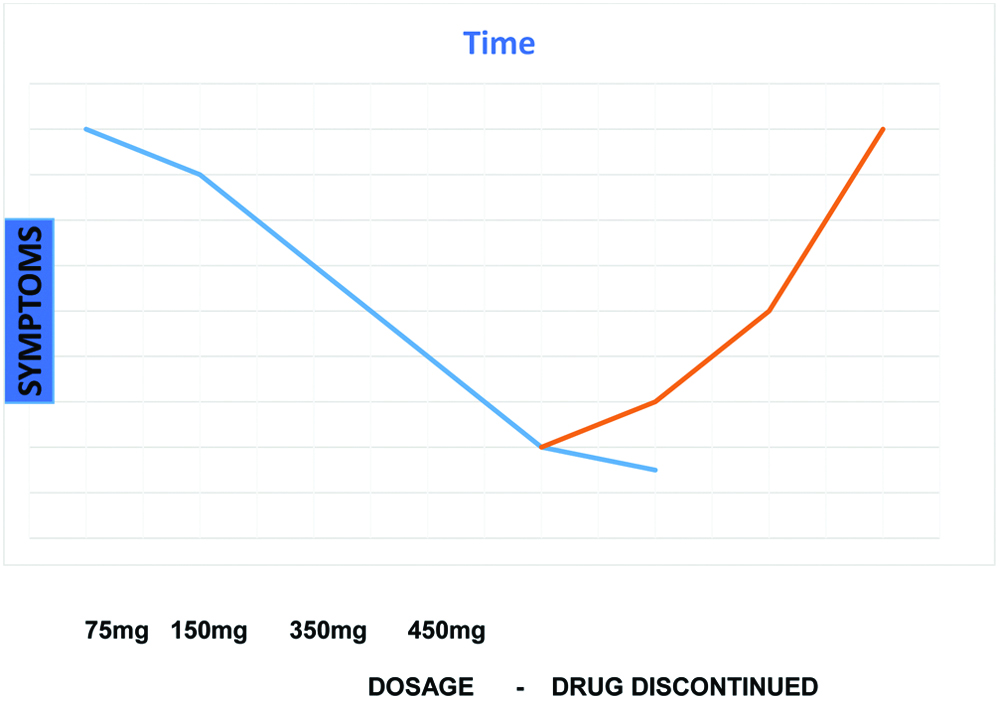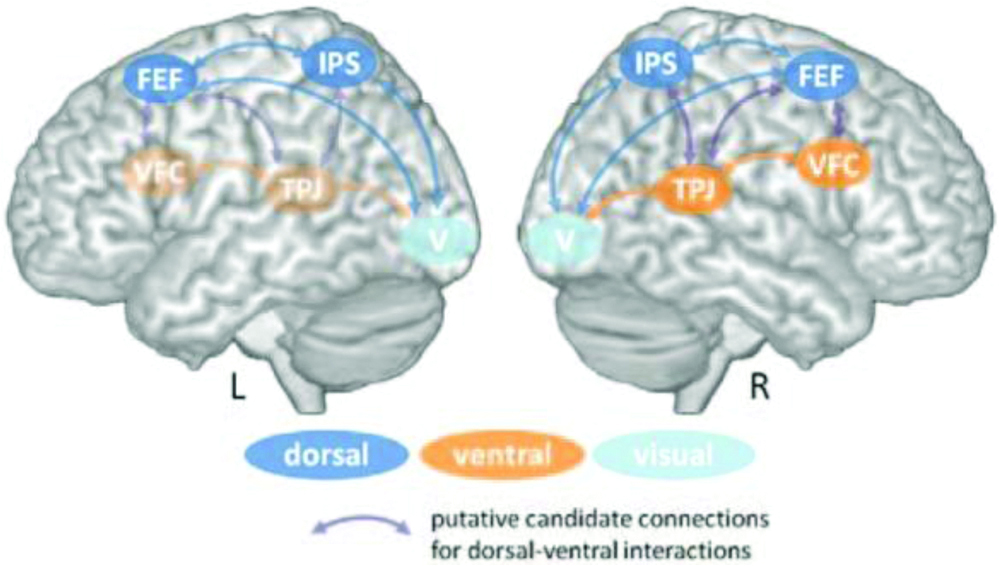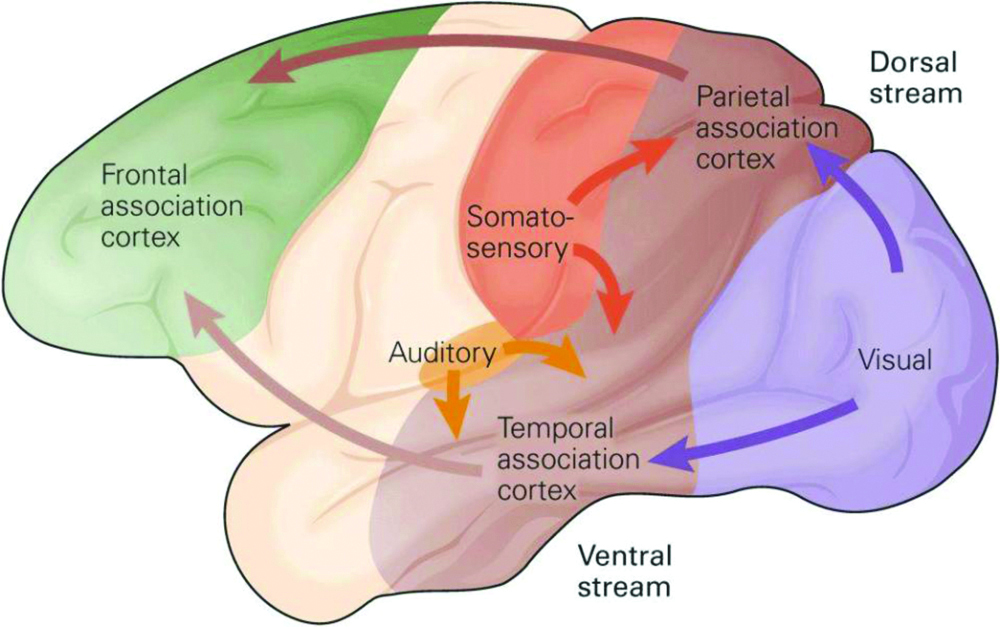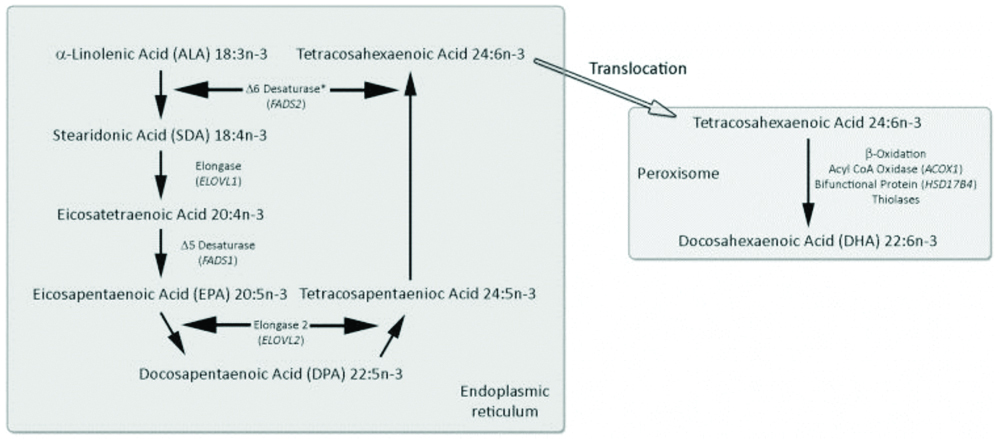Inattentive spells are neurological disorders affecting the neuronal pathways that lead to a decrease in neuronal conduction velocity. The pathways of attention normally function systematically by utilising an electrical conduction system, in order to transmit and process neuronal information. A defect in the attention pathways leads to cognitive impairments that have a detrimental effect on the patient’s health and well-being. Interestingly, patients with a defective attention pathway reported higher incidence of motor vehicle collisions and injuries. The authors report the case of an index patient, 26-year-old female, with chief complaints of frequent prolonged gaze, mild anxiety, insomnia, poor concentration and a decrease in attention span, to assess the correlation between neuronal pathway defects and the efficacy of Omega 3-6-9 treatment. Also, to facilitate the conduction velocity between the neurons. The patient’s symptoms and progression were observed during a five months period. This patient after being treated with Omega 3-6-9, noticed a drastic improvement in concentration, mood, and circadian rhythm. However, after an abrupt interruption of the treatment, her symptoms recurred over a short period of time.
Case Report
A 26-year-old female presented with frequent prolonged gaze, mild anxiety, insomnia, poor concentration and a decrease in attention span that generally lasted for two to three minutes. The patient immigrated to the United States at the age of 16 and noted similar symptoms of mild inattentive spells throughout her childhood that were not as profound. The patient reported ten traffic violations and eight motor vehicle accidents, which resulted in frequent hospitalisations.
The medical, surgical history, prenatal and neonatal history was non-contributory. Furthermore, there was no family history of similar symptoms or relevant conditions. An assessment of the neurological, mental status, cardiac, respiratory, gastrointestinal systems provided normal findings. Additionally, normal diagnostic results were obtained from the electroencephalogram, magnetic resonance imaging, electrolytes, complete blood count, iron panel, serum ceruloplasmin, urine copper level, urinalysis, liver, renal function, thyroid function, and antinuclear antibody tests.
The differential diagnosis thought of was, sluggish cognitive tempo, hepatolenticular disease, lead poisoning, and absent seizure. The sluggish cognitive tempo is the term for a syndrome now called as “concentration deficit disorder” [1]. The causes for the phenomenon are unknown, and the patient typically presents with daydreaming, mental fogginess, hypoactivity, and slow processing speed [Table/Fig-1] [2].
Difference between sluggish cognitive tempo and inattentive spells [2].
| Sluggish cognitive tempo | Inattentive spells |
|---|
| Prone to daydreaming | Higher incidence of motor vehicle accidents |
| Easily confused or foggy | Staring and responds quickly |
| Patient response rate is minimal | School performance not affected |
| Distracted or inattentive to surrounding | Poor concentration |
| Slow moving | |
| Lethargic | |
| Sleepy or drowsy | |
| Apathetic or withdrawn (less engagement in activities) | |
| Forgetful | |
| Information processing is slow and school performance is affected | |
Absence seizure “petit mal” is a generalised onset seizure that occurs in both hemispheres of the brain simultaneously. Absence seizure has a 3HZ spikes in pattern of the electroencephalogram and is generally more common amongst children and only affects the person’s awareness [3]. The affected individual may become silent and unresponsive to a verbal stimulus, gazing blankly into the distance, lip-smacking, rapid chewing movements, and rubbing of the fingers [4]. The EEG of absence seizure is abnormal and typically responds to treatments. Lead poisoning affects an individual at any age especially those living in a property that utilises lead-based paint [4]. The presentation is tremor, constipation, lead line on the gingiva, and abnormal memory function. Hepatolenticular disease, formally known as Wilson syndrome, is an autosomal recessive condition due to a mutation in the Wilson disease protein gene [4]. It affects the liver and the lenticular nuclei of the brain due to an abnormal accumulation of copper in the liver and brain. Typically, the patients will present with tremors, personality and behavioural changes, Kaiser flusher ring, and abnormal liver function tests [4].
Finally, it was concluded that the patient’s symptoms coincided with inattentive spells and was treated as such. Following a long discussion with the patient about the symptoms and treatment options, the patient was treated with OMEGA 3-6-9 to enhance the conduction velocity and improve the neuronal cells function. The initial treatment was administered at a low dosage which was 75 mg that was subsequently increased to 450 mg, until the symptoms subsided completely [Table/Fig-2].
The blue line shows dropping in the patient symptoms as the dosage of Omega 3-6-9 was increased over a period of time. The orange line shows the recurrence of symptoms over short period when the Omega 3-6-9 was stopped.

The patient was followed-up and closely monitored for adverse effects and the response to treatment for a five months period. Clinically, the symptoms of the patient improved gradually throughout the first three to four weeks and subsided completely within five months. The adverse effects that occurred at the beginning of the treatment consisted mainly of gastrointestinal symptoms such as nausea, vomiting, bloating, and diarrhea. However, these adverse effects subsided without any intervention within the first 10 days of treatment. The patient returned to normal status and the symptoms were completely diminished within five months.
After obtaining such positive results, the patient was instructed to stop OMEGA 3-6-9 abruptly, in order to monitor for any recurring symptoms. The patient began experiencing similar symptoms as previously stated. However, four days later, the patient was started on the OMEGA 3-6-9 treatment again and the symptoms resolved rapidly within eight to ten days. In addition to the OMEGA 3-6-9 treatment, the patient’s dietary intake of modified foods such as walnuts, seeds (flax, chia) and almonds were included in the dietary plan.
Discussion
Inattentive spell is a unique clinical disorder caused by abnormal or slowness in the conduction velocity between the neurons that subsequently lead to prolonged gaze and loss of focus inattentively. It is crucial to diagnose such spells and manage them appropriately. Ignoring such spells can lead to motor vehicle accidents and serious injuries. The pathophysiology underlying the inattentive spells is not well understood; however, it is hypothesised that there is a delay in the conduction pathway between the neurons. Literature mentions that such spells generally persist for a short period of time in children and is subsequently resolved throughout the adolescence [4].
Based on the research conducted, it is appropriate to hypothesise that inattentive spells are quite dissimilar from the spells that occur in children, due to differences in time and the propensity to resolve on its own as the child develops. In order for attention and focus to be intact, the three attention pathways of ventral, dorsal and visual aspects of the brain must function correctly and in high velocity [5]. The dorsal fronto-parietal system mediates the top-down guided voluntary allocate attention to locations or certain features while; ventral fronto-parietal is involved in detecting unattended or unexpected stimuli and triggering shifts of attention. The ventral network consists of the temporo-parietal junction, and ventral frontal cortex responds when relevant stimuli occur unexpectedly [6].
According to Posner’s theories, there are three attention theory {subcortical system (alerting), posterior system (orienting), and anterior system (Executive control)} [6]. The subcortical system has the locus coeruleus that is activated following a warning signal which secretes norepinephrine to regulate alertness. Furthermore, the right hemisphere is involved in slower tonic alertness, while the left hemisphere is involved in rapid and phasic alertness. The posterior system focuses on the ability to list sensory information and Posner cueing tasks which measure the validity effect. The anterior system comprises the fronto-parietal network which has the precuneus, medial cingulate cortex, dorsolateral prefrontal cortex, dorsal frontal cortex, inferior parietal sulcus, and inferior parietal lobule. The anterior also has the cingulo-opercular network (maintain ongoing task) [6].
The dorsal network [Table/Fig-3] [6] consists of the intraparietal sulcus and frontal eye field. These areas are active when attention is overtly or covertly oriented in space, and these are responsible for spatial awareness and recognition for objects located in space; they are relatively fast and used for short-term memory only. It has two functions- detailed mapping of the visual field and detection and analysis of movements. The ventral pathway [Table/Fig-3] is connected to the limbic system, the medial temporal lobe (memory), and the dorsal pathway. The ventral pathway is relatively slow but carries long-term memory and is used for recognition or identifications. It comprises the Temporoparietal Junction (TPJ) and the ventral frontal cortex and responds when relevant stimuli present unexpectedly. The TPJ act as a circuit-breaker for the dorsal network which is difficult to perpetuate [6]. The ventral and dorsal networks are functionally specialised nodes promoting specific processes for attentional control. These pathways with the visuo-spatial attention system work in conjunction to keep the person attentive and connected to maintain focus and attention. It is reasonable to hypothesise that the decrease in velocity of conduction, if occur throughout these pathways, lead to symptoms of prolonged gazing. The treatment with Omega-3-6-9 enhances the pathways and improve the patient’s symptomatology [Table/Fig-4] [7].
Schematic illustration of the components of the dorsal (blue) and ventral (orange) attention systems in the brain. Showing bilateral organisation of dorsal system and the ventral system more lateralized to the right hemisphere. FEF=Frontal eye fields; IPS=Intraparietal sulcus; VFC=Ventral frontal cortex; TPJ=Temporoparietal junction; V=Visual cortex [6].

Schematic illustration of the dorsal, ventral and visual systems of the cerebral cortex. Lower order sensory area sends the output to the parietal and temporal area which then send the information to the frontal area. Parietal cortex sends output information to the dorsal part of frontal cortex for motor and executive functions. Temporal cortex sends output information to the ventral part of frontal cortex for emotional response function [7].

The OMEGA 3-6-9 consists of essential fatty acids and these fatty acids must be supplied by dietary intake in order to meet the body’s demand. One of these essential fatty acids is linolenic acid, which is an extremely essential fatty acid for neuronal function as it is converted into three important components; Eicosapentaenoic acid (EPA), Docosahexaenoic acid (DHA), and Docosapentaenoic acid (DPA) [8]. Such byproducts are not sufficiently produced by the body in order to meet the neurons’ requirements, so they must be supplied with diet [9]. The EPA, DHA, and DPA carry an essential function in facilitating the development of stem cells and myelination of neurons [9]. They enhance neurite outgrowth, synaptogenesis, and differentiation of neural stem cells [10]. Supplying them with diet or using them as a supplement will promote neurite and enhance the conduction velocity to control the attention [Table/Fig-5] [11].
Synthesis of EPA, DPA and DHA from ALA. The longer chain omega-3 Polyunsaturated Fatty Acids (PUFAs) are synthesised from ALA by a progressive series of enzymatic desaturation and chain elongation steps, initially in the endoplasmic reticulum. In the final stage tetracosahexaenoic acid (24:6n-3) is translocated to the peroxisome and is shorted by one cycle of the β-oxidation pathway to form DHA (22:6n-3) [11].

In addition, Omega 3-6-9 drastically improves patient’s symptoms and plays a key role in the synthesis of cellular membranes and the increase in the neuron’s synapses, in order to properly propagate impulses between the neurons [12]. Literature states that utilising an Omega supplement during pregnancy might improve the neurological, visual, and cognitive functions of the developing foetus [13]. Also, it is believed that certain environmental factors contribute to the exacerbation and the chronicity of this particular condition. The index patient lived in various Mediterranean countries within the first 16 years of her life. Although the patient stated that she experienced similar symptomatology during childhood, it was not as chronic or noticeable. However, after she immigrated to the United States, the symptoms became severe and her mental condition began to deteriorate. This provides a key evidence that certain environmental factors and dietary intake has a profound effect on the patient’s health condition. Moreover, recent studies mention that the Mediterranean diet is rich in Omega 3-6, considering that it mainly consists of foods such as beef, vegetable oils (primrose, fish, black currant, and sunflower), eggs, and dairy products [14]. Based on these variables, the patient was instructed to modify her dietary intake and increase the consumption of foods that are high in omega fatty acids. As a result, the patient’s symptoms subsided and there was a substantial improvement in her condition after utilising the combined OMEGA 3-6-9 treatment with the diet.
Conclusion(s)
Inattentive spell is due to defect in the conduction pathway of the attention system and causes patient to suffer for prolonged stare and poor concentration. The effective treatment is to enhance the conduction and help the patient to concentrate. Therapy with OMEGA 3-6-9 and diet modification brings in positive response.
[1]. Hartman CA, Willcutt EG, Rhee SH, Pennington BF, The relation between sluggish cognitive tempo and DSM-IV ADHDJ Abnorm Child Psychol 2004 32(5):491-503.10.1023/B:JACP.0000037779.85211.2915500029 [Google Scholar] [CrossRef] [PubMed]
[2]. Barkley RA, Sluggish cognitive tempo/concentration deficit disorderOxford Handbooks Online 2015 15(1)Available from https://www.oxfordhandbooks.com/view/10.1093/oxfordhb/9780199935291.001.0001/oxfordhb-9780199935291-e-910.1093/oxfordhb/9780199935291.013.9 [Google Scholar] [CrossRef]
[3]. Bhandari S, What is sluggish cognitive tempoWebMD {Internet} 2018 {cited 2019 Dec 3} Available from https://www.webmd.com/add-adhd/childhood-adhd/sluggish-cognitive-tempo [Google Scholar]
[4]. Ralston S, Penman I, Strachan M, Hobson R, Davidson’s Principles and Practice of Medicine 2018{cited 2019 Dec 3} 23rd Edition(3)Elsevier {Internet}:12-1440.Available from https://www.elsevier.com/books/davidsons-principles-and-practice-of-medicine/ralston/978-0-7020-7028-0 [Google Scholar]
[5]. Vossel S, Geng JJ, Fink GR, Dorsal and ventral attention systemsNCBI/Neuroscientist 2014 20(2):150-59.10.1177/1073858413494269 [Google Scholar] [CrossRef]
[6]. Essen V, The organization of cognitionNeupsy Key 2017 2017(1):01-19. [Google Scholar]
[7]. Themes UFO, The Organization of Cognition [Internet]Neupsy Key 2017 [cited 2019 Jul 21] Available from https://neupsykey.com/the-organization-of-cognition/ [Google Scholar]
[8]. Blasbalg TL, Hibbeln JR, Ramsden CE, Majchrzak SF, Rawlings RR, Changes in consumption of omega-3 and omega-6 fatty acids in the United States during the 20th centuryAm J Clin Nutr/NBCI 2011 93(5):950-62.10.3945/ajcn.110.00664321367944 [Google Scholar] [CrossRef] [PubMed]
[9]. Meyer BJ, Are we consuming enough long chain omega-3 polyunsaturated fatty acids for optimal health? Prostaglandins, Leukotrienes and Essential Fatty Acids (PLEFA)Science direct 2011 85(5):275-80.10.1016/j.plefa.2011.04.01021571516 [Google Scholar] [CrossRef] [PubMed]
[10]. Hjalmarsdottir F, 17 Science-Based Benefits of Omega-3 Fatty AcidsNatural health center. Natural Health Center {Internet} 2018{cited 2019 Dec 3} :01-17.Available from https://naturalhealingcenter.us/17-benefits-of-omega-3-fatty-acids/ [Google Scholar]
[11]. Dyall SC, Long-chain omega-3 fatty acids and the brain: A review of the independent and shared effects of EPA, DPA and DHAFront Aging Neurosci/Ncbi {Internet} 2015{cited 2019 Dec 3} 7:52Available from https://www.ncbi.nlm.nih.gov/pmc/articles/PMC4404917/10.3389/fnagi.2015.0005225954194 [Google Scholar] [CrossRef] [PubMed]
[12]. Dyall SC, Michael-Titus AT, Neurological benefits of omega-3 fatty acidsNeuromol Med 2008 10(4):219-35.10.1007/s12017-008-8036-z18543124 [Google Scholar] [CrossRef] [PubMed]
[13]. Simopoulos AP, Fish and fish oil in the mediterranean dietsFish and fish oil in health and disease prevention10.1016/B978-0-12-802844-5.00002-6;15-25 [Google Scholar] [CrossRef]
[14]. Slomski A, Fish oil in pregnancy stimulates growth in childrenJAMA 2018 320(16):163110.1001/jama.2018.15678 [Google Scholar] [CrossRef]